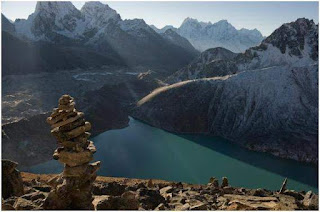Description :
Sagarmatha is an exceptional area of dramatic mountains, glaciers and valleys that it looks very natural, dominated by Mount Everest, which is the world's highest peak (8848 m). Several rare species, such as snow leopards and pandas small, can you meet at this place.
The Sagarmatha National Park includes the highest point of the Earth's surface, Mount Everest (Sagarmatha). The park is also of major religious and cultural significance in Nepal as it abounds in holy places such as the Thyangboche and also is the homeland of the Sherpas whose way of life is unique, compared with other high-altitude dwellers.
The park encompasses the upper catchments of the Dudh Kosi River system, which is fan-shaped and forms a distinct geographical unit enclosed on all sides by high mountain ranges. The northern boundary is defined by the main divide of the Great Himalayan Range, which follows the international border with the Tibetan Autonomous Region of China. In the south, the boundary extends almost as far as Monjo.
There are approximately 2,500 Sherpa people living within the park. The people are primarily Tibetan Buddhists. Their activities are primarily agricultural or trade based. Their properties have been excluded from the park by legal definition. There is and will continue to be an influence on the people by the park and vice versa. The Sherpas are of great cultural interest, having originated from Salmo Gang in the eastern Tibetan province of Kham, some 2,000 km from their present homeland. They probably left their original home in the late 1400s or early 1500s, to escape political and military pressures, and later crossed the Nangpa La into Nepal in the early 1530s. They separated into two groups, some settling in Khumbu and others proceeding to Solu. The two clans (Minyagpa and Thimmi) remaining in Khumbu are divided into 12 subclans. Both the population and the growth of the monasteries took a dramatic upturn soon after that time. The Sherpas belong to the Nyingmapa sect of Tibetan Buddhism, which was founded by the revered Guru Rimpoche who was legendarily born of a lotus in the middle of a lake. There are several monasteries in the park, the most important being Tengpoche.
In common with the rest of the Nepal Himalaya, the park has a comparatively low number of mammalian species, apparently due to the geologically recent origin of the Himalaya and other evolutionary factors. The low density of mammal populations is almost certainly the result of human activities. Larger mammals include common langur, jackal, a small number of wolf, Himalayan black bear, red panda, yellow-throated marten, Himalayan weasel, masked palm civet, snow leopard, Himalayan musk deer, Indian muntjac, serow, Himalayan tahr and goral. Sambar has also been recorded. Smaller mammals include short-tailed mol, Tibetan water shrew, Himalayan water shrew; marmot, woolly hare, rat and house mouse. Inskipp lists 152 species of bird, 36 of which are breeding species for which Nepal may hold internationally significant populations. The park is important for a number of species breeding at high altitudes. The park's small lakes, especially those at Gokyo, are used as staging points for migrants. A total of six amphibians and seven reptiles occur or probably occur in the park.
Automotive : inex-cars.blogspot.com 








{ 0 komentar... Views All / Send Comment! }
Post a Comment